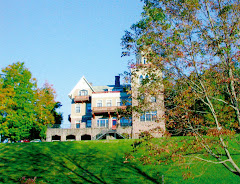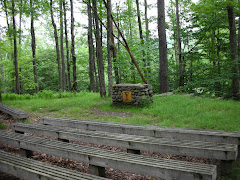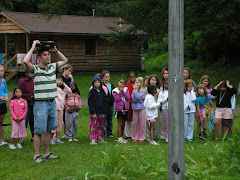
One of the counselors in Windsong - Anna Armstrong, who herself has been here for years beginning as a young camper - organized a double-period session with me yesterday here in the Historical Room of the Ad Office. We gathered her and I described what was in the Frost Valley/Wawayanda archive, a deep closet now very very well organized with file drawers, archive boxes, deeds and meeting minutes and annual reports, photos, old issues of
The Wawayanda Whirlwind and the
Wawayanda Wasp and
Frost Valley Life, staff lists and even camper lists for early years.
Carefully recording the files removed, we handed our archive folders to each of the girls who wanted to read them. Others sorted through old staff shirts dating back to the 1960s, others read through the 1979-1980 Staff Wellness Manual with the idea of comparing our ideas about health and wellness now with these revolutionary ideas of the late 70s, and still another group sat my computer and tried to Google the names of campers from the 1968 camper lists, seeing if we could locate any. (We did!)
Melanie Vargas took notes on wellness then and now. She wrote this, in part: "No TCS. No Too Cool Syndrome. No camper should be 'too cool' for any activity. This creates a stress-free environment. This makes FV the true melting pot America is supposed to be. The country itself may only be the ingredients but Frost Valley is the real melting pot where the flavors blend to become the tempting stew. From
Building Wellness Lifestyle page 4, paragraph 1, line 2, I read: 'Learn more from what we do than from what we say.' Recently a counselor said to me, "Youdon't realize what an effect you have on us." Just yesterday I learned about Sunshine Village [a one-week village of kids undergoing drug rehab]. It's meant to show those just out of rehab what else there is, what opportunities they have. Having attended FV myself since 10 years old I've been exposed to those opportunities. I'd never have been so liberal, open-minded, or cultured without this place. Here we're away from the judgments and harsh cruelty of society. In a few short weeks here we lose our own judgments and gossip doesn't change our opinions. First impressions don't matter. All campers gain courage and confidence."

During our session our CEO Jerry Huncosky stopped in to talk with the girls. One of the girls was reading through a long-range planning document that called for the replacement of all cabins with lodges, one super-lodge for each existing village of five cabins. She asked Jerry his view of the cabins vs. the lodges. Before he describe his preference (strongly for the cabins) the girls discussed it with them. All but one preferred the cabins. Later Georgia Gleason wrote about this: "Campers at Frost Valley who have lived in lodges and cabins usually have an opinion about which they prefer.... It's cool in the cabins to look at all the names and dates carved in the walls. Thinking about all the different girls and boys who slept in the bunks long ago is interesting to dream about. Cabins provide 8 individuals the same age an opportunity to bond and grow very close to each other. Lodges on the other hand hold more people and allow everyone to be part of a bigger family. Lodges such as Kresge [where Windsong lives] are really great because they have a main room in the center where the girls meet to hang out and say goodnight. Wherever you stay at Frost Valley there will be fun things to do, great times to experience, and the most fun, cool and exciting people on earth."
Tammy Oruwariye became fascinated with a document dated 1966. The "Construction Engineers" (CE) program had not gone well the previous summer apparently. "Bad leadership" was the complaint and the situation was presented to the trustee-led "Wawayanda Committee," which recommended at one of its fall meetings that the CE Program be discontinued. Tammy asked me what the CE program was and why it was shut down and she wanted to imagine what overnight camping and hiking would be like today if the trails and lean-tos and overnight sites had been kept up by camper volunteers in CE all those summers. She first wrote about her own overnight experiences. Then: "Imagine if we had the CEs now. It would make hiking so much better and easier." The end of the CEs, she wrote, "remains a mystery in my mind." What did she mean by this, I asked her later. "It seems like such a good idea. Maybe we can do something like this again."

Sherley Wetherheld was another who read the Wellness Lifestyles manual and it got her to thinking about her own time here. "As a Windsong camper (the equivalent of Cherokee Village, for those of you who remember playing 45s of the Beatles and the Doors), my last days as a camper loom darkly and inevitable. I have done quite a big of thinking lately. What will I say at Vespers? How have I made my mark on Frost Valley? Will I make CIT? How will my life be changed? I can try to answer one question: What is the allure and magic of Frost Valley? It's the feel-goodness that surrounds us every time we set foot on Frost Valley property. While flipping through "Building Wellness Lifestyles" I realized that all of the ideals Frost Valley stood for in the 70s still hold true in the 21st century. Here's the conclusion of the old booklet:
We hope all of us will agree that after spending the summer together that wellness was never intended to be boring coursework, putting people down, getting everyone to behave the same way, a program for super-jocks, or a drag. It is intended to be health enhancing, enlivening, inspiring, and to make us feel good inside. Which is exactly what Frost Valley does for me. It makes me feel good. The way we all share our secrets and keep them too, the way we become a family, but closer, and know that we will always be friends, and in our hearts, we'll always be campers, and know where to find some of that Frost Valley magic."

I had a centennial year staff T-shirt to give away to one of the Windsong kids at the end of the program but they were all so into this exploration into their camp's history it didn't seem appropriate to single out one kid, but everyone instantly agreed that Anna Armstrong, the counselor who came up with this idea, should have it. She was delighted and wore it the rest of the day. It turns out that today, the next day, she was leaving camp for the summer (needing to go back to college a bit early). So this was a fine farewell gathering, some reflection, some connecting to the larger community here, and a new shirt to prove it. The girls applauded her when she showed them her new FV possession.





























































